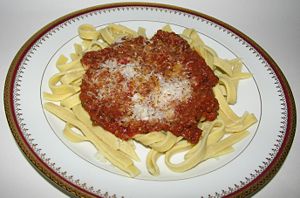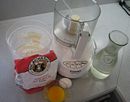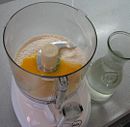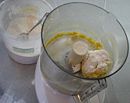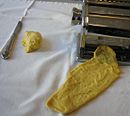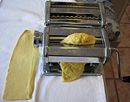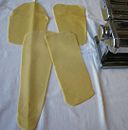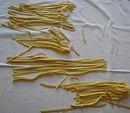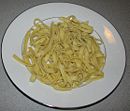Revision as of 11:56, 8 July 2011 by imported>Hayford Peirce
Tagliatelle is a well-known form of pasta that originated in the Emilia-Romagna region of northern Italy, where it is particularly known as being the classic accompaniment to Bolognese sauce. A single piece is a long, flat ribbon indistiguishable from fettuccine except for its slightly greater width of about 1/4th of an inch when cut and expanding up to nearly 1/2 of an inch when cooked. When made at home, as it typically is in Italy, it is too wide to be made in a household pasta machine and must be cut by hand. The noted food-writer Marcella Hazan says that Emilia-Romagna "enjoys uncontested recognition" as the birthplace of Italy's "finest" homemade pasta,[1] although the world-renowned spaghetti is not one of the local specialties. The basic homemade dough for tagliatelle, she says, consists only of eggs and soft-wheat flour, with spinach or Swiss chard being permitted for making green pasta. The homemade version, she notes, is "not as chewy as good factory pasta" and has "the capacity of absorbing sauces deeply."[2] Although spaghetti bolognese has become a worldwide standard, in Italy Bolgonese sauce is almost always served exclusively with tagliatelle.
| A typical homemade preparation of tagliatelle
|
| The ingredients are flour, eggs, and, possibly, a little water
|
| The ingredients in a food processor
|
| Processing until the ingredients form a ball
|
| Ready to be put through a pasta machine
|
| Using the widest thickness
|
| After the first time through the machine
|
| On the left, after 20 times through the machine
|
| Beginning to use a narrower thickness
|
| Rolled through the machine to #3 or #4 thickness
|
| Cutting, although this is actually fettucine width
|
| Buttered, and ready to eat, but without sauce
|
|
References
- ↑ Hazan, page 26
- ↑ Hazan, page 26
Sources
- Essentials of Classic Italian Cooking, by Marcella Hazan, Alfred A. Knopf, New York, 1992, ISBN 0-394-58404-X
See also
